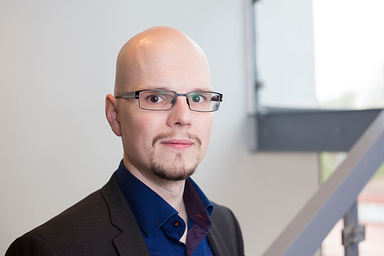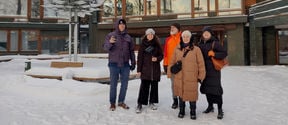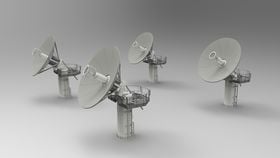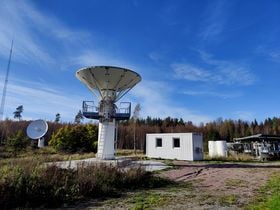Metsähovi Radio Observatory turns 50 and gets new telescopes
The Metsähovi Compact Array (MCA) has produced its first measurements at Aalto University's Metsähovi Radio Observatory. Several students from different disciplines participated in the design and construction of the system, which comprises several 5.5-metre radio telescopes. Multidisciplinary student projects are common at Metsähovi, helping to ensure the continuity of Finland’s versatile space expertise into the future.
‘We’ve now commissioned the first two MCA telescopes, and the construction of the third will begin in summer 2024. The fourth telescope is already waiting in line, and the network can still be expanded further with additional telescopes,’ says Joni Tammi, director of the Metsähovi Radio Observatory.
The process of designing the system began almost ten years ago, and building it has required extensive collaboration between various experts, along with financial investments from many parties.
‘Ever since the 1990s, we’ve made joint observations with several telescopes around the world using our main instrument, the 14-metre radio telescope. The new system of smaller telescopes will function the same way – that is, the telescopes can be used either independently or together as a radio interferometer,’ Tammi explains. Interferometry is a cutting-edge radio astronomy technology that combines individual radio telescopes into one giant telescope, which is how the first image of the black hole was recently captured.
Radio telescopes follow in the footprints of the Aalto satellites
There haven’t been many similar projects in Europe, and this project’s uniqueness in terms of multidisciplinary practical education has been important from the start.
‘Metsähovi's radio telescope system is intended for both educational and research use, and students were involved from the early stages of the construction and design process, just like in Aalto’s nanosatellite projects,’ Tammi explains.
For example, the optimal locations for the radio telescopes were mapped as part of a geology and geophysics course project, while a group of computer-aided design students prepared precise three-dimensional models of the antenna mechanics. The telescopes’ feed horns and data collection systems were the subject of several diploma theses, and their alignments and sensitivity limits were examined in special projects.
‘An engineering student from the Häme University of Applied Sciences is currently designing the calibration of spectral measurements, and an electrical engineering student from Aalto is working on a joint control system for multiple telescopes. This project has provided students with all-new experiences in the field of astronomy – and best of all, the work done in different disciplines has been combined,’ Tammi says.
‘I see lots of opportunities for research and cooperation in the future in the fields of atmospheric research, satellite tracking, and the use of radio telescopes in satellite data reception, for example,’ Tammi says.
Radio telescopes also create new opportunities to connect with schools. Metsähovi Radio Observatory will open its doors to comprehensive and upper secondary school groups during the spring, offering school groups unique hands-on experience in observations and astronomy.
New research at new frequencies
Alongside the students, Metsähovi’s extensive community of staff and personnel have also brought their different competencies and strengths to the design and construction of the telescopes. Research Engineer Derek McKay has been involved with radio telescope construction since the late 1980s. He emphasises that each telescope is different, and each involves new challenges, new technologies and new scientific objectives.
‘Long-term monitoring is a very challenging science. Metsähovi has decades of excellent experience in long-term monitoring. The MCA project will raise this to a completely new level,’ he says.
The first measurements made with the new 5.5 m radio telescope system aren’t astronomical results, strictly speaking, but they play a crucial role in the further design of the telescopes. ‘The first results can be used to adjust the performance of the telescope, which in turn will take us forward towards new, more meaningful results,’ McKay says.
The radio telescope system will enable new research at new frequencies, particularly monitoring the radio spectrum of objects, from which details related to the rotation and orbit of the Earth and the movement of the solar system in the Milky Way can be determined.

Aalto University's Metsähovi Radio Observatory celebrates its 50th anniversary this year. Located in Kirkkonummi, Metsähovi is the only astronomical radio observatory in Finland. Research and technological development at Metsähovi focus on studying space with radio waves. Did you know that exactly half a century ago, on 11 April 1974, our radio telescope recorded its first radio-astronomical observations? Our collections of observational radio data have been expanding ever since. Read more at metsahovi.aalto.fi.
- Published:
- Updated:
Read more news

Viktar Asadchy receives Young Scientist Award
The Finnish Foundation for Technology Promotion awarded Assistant Professor Viktar Asadchy with the Young Scientist 2024 Award.
Preserving intangible cultural heritage through immersive XR experiences
Aalto University’s Department of Art and Media is coordinating a European wide project on preserving intangible cultural heritage and using it to address societal challenges with the help of immersive XR environments.



